Статьи журнала - International Journal of Image, Graphics and Signal Processing
Все статьи: 1056
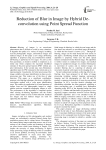
Reduction of Blur in Image by Hybrid De-convolution using Point Spread Function
Статья научная
Blurring of images is an unwelcome phenomenon that is difficult to avoid in many situations. It degrades the quality of a variety of images, including real life photographic images, astronomical images and medical images. In this paper a new image de-blurring algorithm is proposed using Lucy Richardson method. De-blurring is performed in two stages. To arrive at the best guestimate, an iterative method is employed as an initial step which computes the maximum likelihood estimate of the point spread function (PSF) without any prior information. In the second step, Lucy Richardson algorithm takes the PSF estimated in the initial step as its input parameter. In particular, for better processing of the image, suitable color space identification is done as a pre-processing step. This makes use of the idea of edge detectors. This paper, as a significant contribution, proposes a de-blurring technique, which uses a hybrid de-convolution method with a color space identification stage. This enables its application for a broad spectrum of images from real life photographic images to single photon emission computed tomography images as well. The performance of the algorithm is compared against other existing de-blurring algorithms and the results prove a better output in terms of blur reduction. Standard test images and real medical images are used for appraising the algorithm.
Бесплатно
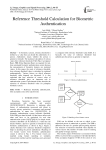
Reference Threshold Calculation for Biometric Authentication
Статья научная
In biometric systems, reference threshold is defined as a value that can decide the authenticity of a person. Authenticity means whether the person is genuine or intruder. The statistical calculation of various values like reference threshold, FAR (False Acceptance Rate), FRR (False Rejection Rate) are required for real-time automated biometric authentication system because the measurement of biometric features are statistical values. In this paper, the need of reference threshold, how reference threshold value is calculated is explained mathematically. Various factors on which reference threshold value depends are discussed. It is also explained that how selection of correct value of reference threshold plays an important role in authentication system. Experimental results describe the selection of reference threshold value for palmprint biometric system.
Бесплатно
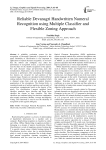
Статья научная
A reliability evaluation system for the recognition of Devanagri Numerals is proposed in this paper. Reliability of classification is very important in applications of optical character recognition. As we know that the outliers and ambiguity may affect the performance of recognition system, a rejection measure must be there for the reliable recognition of the pattern. For each character image pre-processing steps like normalization, binarization, noise removal and boundary extraction is performed. After calculating the bounding box features are extracted for each partition of the numeral image. Features are calculated on three different zoning methods. Directional feature is considered which is obtained using chain code and gradient direction quantization of the orientations. The Zoning firstly, is considered made up of uniform partitions and secondly of non-uniform compartments based on the density of the pixels. For classification 1-nearest neighbor based classifier, quadratic bayes classifier and linear bayes classifier are chosen as base classifier. The base classifiers are combined using four decision combination rules namely maximum, Median, Average and Majority Voting. The framework is used to test the reliability of recognition system against ambiguity.
Бесплатно
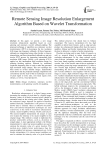
Remote Sensing Image Resolution Enlargement Algorithm Based on Wavelet Transformation
Статья научная
In this paper, we present a new image resolution enhancement algorithm based on cycle spinning and stationary wavelet subband padding. The proposed technique or algorithm uses stationary wavelet transformation (SWT) to decompose the low resolution (LR) image into frequency subbands. All these frequency subbands are interpolated using either bicubic or lanczos interpolation, and these interpolated subbands are put into inverse SWT process for generating intermediate high resolution (HR) image. Finally, cycle spinning (CS) is applied on this intermediate high resolution image for reducing blocking artifacts, followed by, traditional Laplacian sharpening filter is used to make the generated high resolution image sharper. This new technique has been tested on several satellite images. Experimental result shows that the proposed technique outperforms the conventional and the state-of-the-art techniques in terms of peak signal to noise ratio, root mean square error, entropy, as well as, visual perspective.
Бесплатно
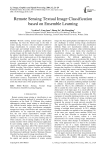
Remote Sensing Textual Image Classification based on Ensemble Learning
Статья научная
Remote sensing textual image classification technology has been the hottest topic in the filed of remote sensing. Texture is the most helpful symbol for image classification. In common, there are complex terrain types and multiple texture features are extracted for classification, in addition; there is noise in the remote sensing images and the single classifier is hard to obtain the optimal classification results. Integration of multiple classifiers is able to make good use of the characteristics of different classifiers and improve the classification accuracy in the largest extent. In the paper, based on the diversity measurement of the base classifiers, J48 classifier, IBk classifier, sequential minimal optimization (SMO) classifier, Naive Bayes classifier and multilayer perceptron (MLP) classifier are selected for ensemble learning. In order to evaluate the influence of our proposed method, our approach is compared with the five base classifiers through calculating the average classification accuracy. Experiments on five UCI data sets and remote sensing image data sets are performed to testify the effectiveness of the proposed method.
Бесплатно
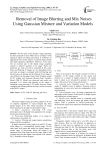
Removal of image blurring and mix noises using gaussian mixture and variation models
Статья научная
For the past recent decades, image denoising has been analyzed in many fields such as computer vision, statistical signal and image processing. It facilitates an appropriate base for the analysis of natural image models and signal separation algorithms. Moreover, it also turns into an essential part to the digital image acquiring systems to improve qualities of an image. These two directions are vital and will be examined in this work. Noise and Blurring of images are two degrading factors and when an image is corrupted with both blurring and mixed noises, de-noising and de-blurring of the image is very difficult. In this paper, Gauss-Total Variation model (G-TV model) and Gaussian Mixture-Total Variation Model (GM-TV Model) are discussed and results are presented. It is shown that blurring of the image is completely removed using G-TV model; however, image corrupted with blurring and mixed noise can be recovered with GM-TV model.
Бесплатно
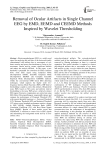
Статья научная
Electroencephalogram (EEG) is a widely used signal for analyzing the activities of the brain and usually contaminated with artifacts due to movements of eye, heart, muscles and power line interference. Owing to eye movement, Ocular Activity creates significant artifacts and makes the analysis difficult. In this paper, a new threshold is presented for correction of Ocular Artifacts (OA) from EEG signal using Empirical Mode Decomposition (EMD), Ensemble Empirical Mode Decomposition (EEMD) and Complete Ensemble Empirical Mode Decomposition (CEEMD) methods. Unlike the conventional EMD based EEG denoising techniques, which neglects the higher order low-frequency Intrinsic Mode Functions (IMFs), IMF Interval thresholding is opted to correct the artifacts. Obtained the noisy IMFs based on MI scores and perform interval thresholding to the noisy IMFs gives a relatively cleaner EEG signal. Extensive computations are carried out using EEG Motor Movement/Imagery (eegmmidb) dataset and compare the performance of Proposed Threshold (PT) with current threshold functions i.e., Universal Threshold (UT), Minimax Threshold (MT) and Statistical Threshold (ST) using several standard performance metrics: change in SNR (ΔSNR), Artifact Rejection Ratio (ARR), Correlation Coefficient (CC), and Root Mean Square Error (RMSE). Results of these studies reveal that CEEMD+PT is efficient to correct OAs in EEG signals and maintaining the background neural activity in non-artifact zones.
Бесплатно
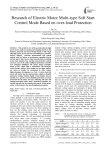
Research of Electric Motor Multi-type Soft Start Control Mode Based on over-load Protection
Статья научная
This article in view of the question that the high power motor could not starting and stopping directly in the industry, proposed one kind of design based on PIC single chip high power motor soft start and intelligence protective devices, utilized real-time measurement and control method with the feature of synchronous sampling electric current spurt value inverse time lag protection, according to the load situation four starting and protection control soft start ways of the under intelligent protection controller were designed. Intelligent soft starter design principles based on PIC single chip is articulated. The hardware circuit design, software flow design and test data analysis are given in details. By producing in Zibo Galaxy high-technology development co., Ltd.,it shows that this smart soft starter has the characteristics which are flexible parameter setting, intuitive liquid crystal display, diverse starting way, precise current limiting protection, accurate protection of lack phase, low-cost, collecting soft start and running protection with a body's protection controller, are suitable specially for the starting and control of high power motor, so the protector has broad application prospects.
Бесплатно
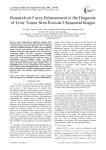
Research on Fuzzy Enhancement in the Diagnosis of Liver Tumor from B-mode Ultrasound Images
Статья научная
Fuzzy enhancement is applied in computer aided diagnosis of liver cancer from B mode ultrasound images as a pre-processing procedure in this paper. It was evaluated with three classifiers including K means, back propagation neural network and support vector machine using 25 features from first order statistic (FOS), gray-level co-occurrence matrix (GLCM), gray-level run-length matrix (GLRLM), Grey level dependant matrix (GLDM) and LAWS. In the analysis of 166 normal liver tissue, 30 hemangioma and 60 malignant tumor, our method improved the classification accuracy of three classifiers (K means, BP neural network and support machine vector) in distinguishing liver cancer, hemangioma and normal liver cancer from B mode ultrasound images. It is proved that fuzzy enhancement as an efficient preprocessing procedure could be used in the computer aided diagnosis system of liver cancer.
Бесплатно
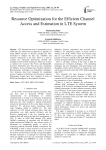
Resource Optimization for the Efficient Channel Access and Estimation in LTE System
Статья научная
LTE Standard has been an inseparable part of 3GPP that was started with an objective to upgrade 3G based Mobile Systems to 4G.This standard has been developed to enhance the data rate, reliability and seamless connectivity to the users. There is a need to evaluate the achievable performance through this standard in terms of MAC parameters. Moreover, in order to optimize the resources like Power and Bandwidth, Extensive Simulations have been done here considering the Medium Access techniques like Channel estimation, Retransmission techniques and Scheduling techniques. Two Scenarios have been designed by considering diverse Conditions of Physical Layer Resources. Optimal Performance bounds have been obtained in terms of BLER and throughput for the proposed Scenarios.
Бесплатно
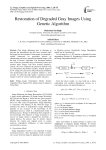
Restoration of Degraded Gray Images Using Genetic Algorithm
Статья научная
This Image deblurring aims to eliminate or decrease the degradations that has been occurred while the image has been obtained. In this paper, we proposed a unified framework for restoration process by enhancement and more quantified deblurred images with the help of Genetic Algorithm. The developed method uses an iterative procedure using evolutionary criteria and produce better images with most restored frequency-content. We have compared the proposed methods with Lucy-Richardson Restoration method, method proposed by W. Dong [34] and Inverse Filter Restoration Method; and demonstrated that the proposed method is more accurate by achieving high quality visualized restored images in terms of various statistical quality measures.
Бесплатно
Retinal Blood Vessel Segmentation with Optic Disc Pixels Exclusion
Статья научная
The morphological changes of retinal blood vessels are important indicators used to diagnose and monitor the progression of various diseases. A number of retinal blood vessel segmentation methods have been introduced, including the line operator based methods, which have shown satisfactory results. However, the basic line operator method cannot discriminate the pixels around the retinal optic disc, resulting in false classification of those pixels. In this paper, we integrate the detection of pixels around the retinal optic disc to the line operator method so that those pixels can be excluded from the vessel pixels. The method is evaluated on the widely used retinal dataset, the DRIVE dataset. The results demonstrate that the proposed method has made improvements over the basic and the multi-scale line detector with accuracy and area under curve of 0.942 and 0.9521, respectively.
Бесплатно
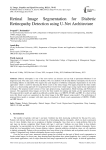
Retinal Image Segmentation for Diabetic Retinopathy Detection using U-Net Architecture
Статья научная
Diabetic retinopathy is one of the most serious eye diseases and can lead to permanent blindness if not diagnosed early. The main cause of this is diabetes. Not every diabetic will develop diabetic retinopathy, but the risk of developing diabetes is undeniable. This requires the early diagnosis of Diabetic retinopathy. Segmentation is one of the approaches which is useful for detecting the blood vessels in the retinal image. This paper proposed the three models based on a deep learning approach for recognizing blood vessels from retinal images using region-based segmentation techniques. The proposed model consists of four steps preprocessing, Augmentation, Model training, and Performance measure. The augmented retinal images are fed to the three models for training and finally, get the segmented image. The proposed three models are applied on publically available data set of DRIVE, STARE, and HRF. It is observed that more thin blood vessels are segmented on the retinal image in the HRF dataset using model-3. The performance of proposed three models is compare with other state-of-art-methods of blood vessels segmentation of DRIVE, STARE, and HRF datasets.
Бесплатно
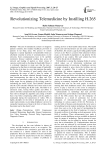
Revolutionizing Telemedicine by Instilling H.265
Статья научная
The aim of telemedicine system is to diagnose patients remotely; this includes healthcare provision to patients in far flung areas. The process of remote diagnosis is mainly dependent on bandwidths which are absolutely essential in terms of communications via the networks. Such communications have to be carefully monitored, because randomly sending data across the network and loading of packets as direct stream of cameras would result in chocking the bandwidth. Hence it is extremely important to make sure that the data is compressed so that there is minimum usage of bandwidth. But this has to be done in a way that maintains the quality at its best. This retention of good quality along with minimizing the usage of data is done by means of compression the streams obtained through cameras and then decompressing the data at the other end. This purpose was previously achieved by H.264 codec. Our major target was up gradation of the existing codec by introducing the latest; H.265. The Libde265 (Decoder) and the x265 (encoder) libraries have been used for the purpose of developing the H.265 codec. The H265 is an advanced codec, having better quality and ability to achieve far better compression than its predecessor. It has been shown through the algorithm and coding of H.265 that is has better compressing ability and the quality is maintained during the transmission of videos. This is highly desirable for the field of telemedicine as it can make improvements in providing healthcare services by easing the transmission of data in the form of videos from the patient end to the doctor’s end.
Бесплатно
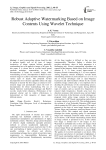
Robust Adaptive Watermarking Based on Image Contents Using Wavelet Technique
Статья научная
A good watermarking scheme should be able to perform equally well on all types of images irrespective of image contents because practically watermarking has to be applied to images of all types. In this paper, it is shown that in wavelet based spread spectrum technique, watermarking at level 1 decomposition is better for textured images while watermarking at level 2 decomposition is better for non-textured images to achieve maximum robustness against various types of attacks. The proposed wavelet decomposition level selection algorithm utilizes the edge histogram to classify the host image as textured or non-textured image and automatically selects the level of decomposition for robust watermarking. The use of Spread Spectrum watermarking technique and Bior6.8 wavelet, results better robustness. Performance of the proposed scheme and its relative effectiveness is demonstrated on both categories of images under different attacks.
Бесплатно
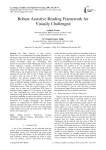
Robust Assistive Reading Framework for Visually Challenged
Статья научная
The Main objective of this assistive framework is to communicate the textual Information in the image captured by the Visually Challenged person as Speech, So that the Visually Challenged person can acquire knowledge about the surrounding. This framework can help Visually Challenged person to read books, magazine, warnings, instructions and various displays as well by taking their image along with the surrounding. Then the Optical Character Recognition (OCR) extracts and recognizes the text in the image and generates the text file. This text file is further converted to Speech with the help of Text to Speech (TTS) Synthesis. The inherent problem with the previous approach was if the acquired image is affected with the issues of different lighting conditions, noise and issue of Skew and Blur, as the image is captured by Visually Challenged person. Then the overall accuracy of the system was at stake due to inefficient OCR leads to improper Speech output of TTS Synthesis. In this paper we have introduced two more processes that are deblurring using Blind Deconvolution method and Pre-processing operation to remove the effect of noise and blur. Thus it prepares the image for efficient result of the framework for Visually Challenged. The proposed approach is implemented in Matlab with the image captured manually and taken from the internet and the result along with the OCR text file and corresponding output Speech shows that our framework is better than the previous framework.
Бесплатно
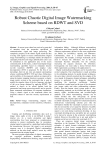
Robust Chaotic Digital Image Watermarking Scheme based on RDWT and SVD
Статья научная
In recent years chaos has received a great deal of attention from the researches specialized in communications, signal and image processing. The complexity property of the chaotic signal raised the idea of using such signals in secure communications. Digital image watermarking is a technique mainly developed for copyright protection and image authentication and it can be considered as one application area of the secure communication. In this study, a chaos based digital image watermarking algorithm based on redundant discrete wavelet transform (RDWT) and singular value decomposition (SVD) is proposed. To the best of our knowledge, there do not exist any digital watermarking scheme combining RDWT, SVD and chaos. Robustness and invisibility of the proposed method are improved by using the logistic mapping function to generate a chaotic image matrix serving as the watermark that is used to modify the singular values of the low frequency sub-band of the cover image obtained by applying RDWT. The method is shown to be robust against both the geometrical and image processing attacks and to provide better watermark concealment via computer simulations. Using a chaotic signal as the watermark allows the proposed scheme to meet the security requirements as well.
Бесплатно
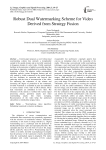
Robust Dual Watermarking Scheme for Video Derived from Strategy Fusion
Статья научная
Current paper proposes a novel robust dual watermarking scheme that entrench a decipherable sample in the spatial domain and an invisible watermark in frequency domain of a color video. Visible watermark facilitate in the protection of publicly accessible data thus providing an imperative contribution for avoiding illegal duplication of data. The adaptive visible watermarking algorithm exploits various histogram features and not only embeds a visible watermark in the spatial domain but also facilitates its extraction and removal thus endowing with the facet of reconstruction of the video. For enhancing the robustness of the scheme and increasing the degree of protection of the watermark, invisible watermark is scrambled in parts and embedded in various frames of the video in DCT domain. These dual watermarks are embedded in host video. The robustness of the scheme is verified with various signal processing attacks, geometric attacks and video watermarking attacks like frame averaging. Reconstruction of the video helps the authorized subscribers to refurbish the original video.
Бесплатно
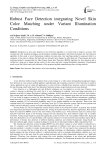
Robust Face Detection integrating Novel Skin Color Matching under Variant Illumination Conditions
Статья научная
Integration of skin color property in face detection algorithm is a recent trend to improve accuracy. The existing skin color matching techniques are illumination condition dependent, which directly impacts the face detection algorithm. In this study, a novel illumination condition invariant skin color matching method is proposed which is a composite of two rules to balance the high and low intensity facial images by individual rule. The proposed skin color matching method is incorporated into Haar Feature based Face Detection (HFFD) algorithm for face detection and is verified on a large set of images having variety of skin colors and also varying illumination intensities. Experimental results reveal the effectiveness and robustness of the proposed method outperforming other existing methods.
Бесплатно
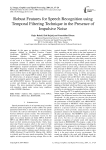
Статья научная
In this paper we introduce a robust feature extractor, dubbed as Modified Function Cepstral Coefficients (MODFCC), based on gammachirp filterbank, Relative Spectral (RASTA) and Autoregressive Moving-Average (ARMA) filter. The goal of this work is to improve the robustness of speech recognition systems in additive noise and real-time reverberant environments. In speech recognition systems Mel-Frequency Cepstral Coefficients (MFCC), RASTA and ARMA Frequency Cepstral Coefficients (RASTA-MFCC and ARMA-MFCC) are the three main techniques used. It will be shown in this paper that it presents some modifications to the original MFCC method. In our work the effectiveness of proposed changes to MFCC were tested and compared against the original RASTA-MFCC and ARMA-MFCC features. The prosodic features such as jitter and shimmer are added to baseline spectral features. The above-mentioned techniques were tested with impulsive signals under various noisy conditions within AURORA databases.
Бесплатно

